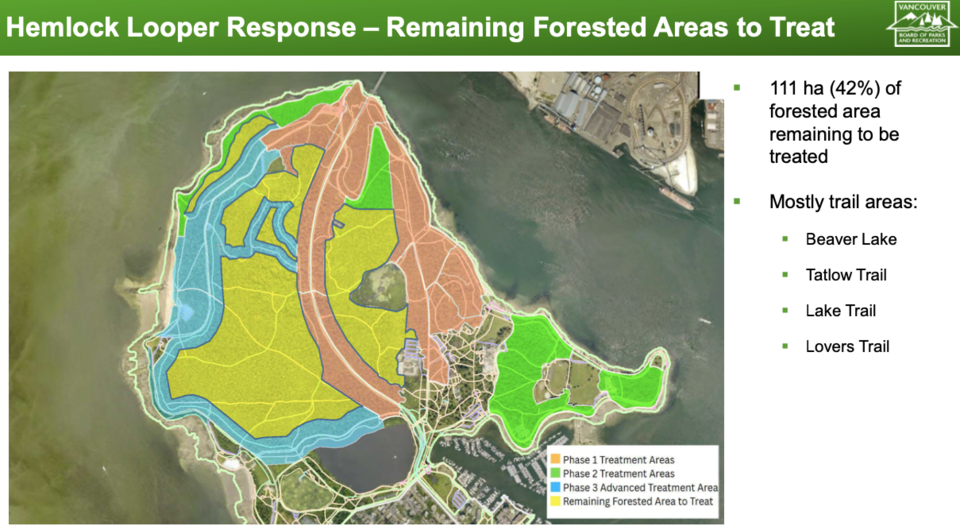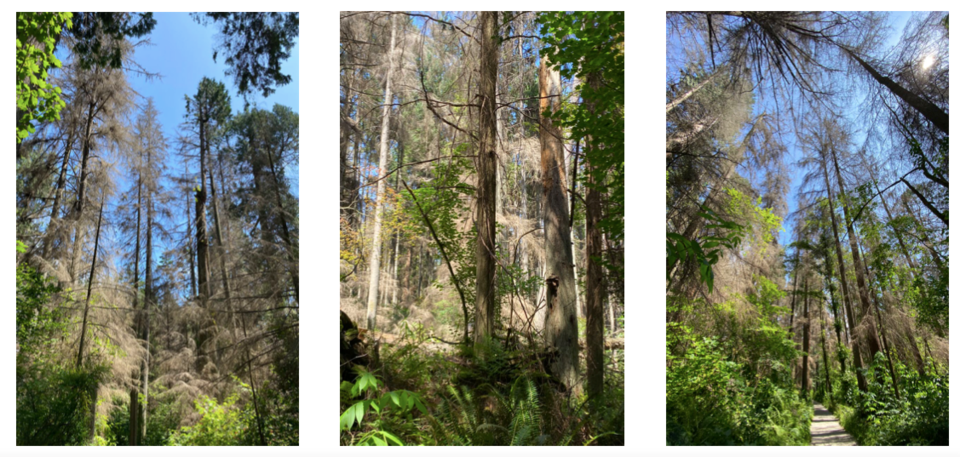Vancouver park board commissioners voted Monday to keep the same contractor on the job for the continued work required to remove dead and declining trees in Stanley Park that have been damaged by a hemlock looper moth infestation.
The board now has to finalize a contract with B.A. Blackwell and Associates Ltd. for the final phase of mitigation and restoration work in the park. The contract will be worth more than $3 million and fall within a previously approved overall budget of $17.9 million for the project.
Although 23 suppliers registered an interest to complete the work, only Blackwell chose to submit a proposal, which was reviewed by the board’s evaluation team comprised of staff from urban forestry and supply chain management.
At Monday’s meeting, park commissioner Laura Christensen asked Joe McLeod, the board’s associate director of urban forestry, to provide insight into why Blackwell was the lone bidder for the final phase, when there was interest from multiple qualified firms.
“I've had this conversation with our procurement team, and while we can't provide an exact reason — it's purely speculation — but I think based on our analysis of the market, it's a very unique skill set [that Blackwell has],” McLeod said.
“There are very few, I would say, forestry professional consulting firms that have this kind of set of unique relationships with contractors that provide this suite of services in urban environments.”
He noted Blackwell was the preferred company to complete previous phases of the work in Stanley Park. Park board retained Blackwell in November 2022 and the company has done similar work on the North Shore and in Coquitlam.
“So I think from an outside perspective, if you're a forestry consulting firm within the region, you're likely well aware of that,” he continued.
“So there may be a general understanding that somebody who has all that knowledge — kind of on-the-ground knowledge — perhaps has a competitive advantage. And I think that's probably one of the big reasons that we saw only a single bidder.”

Lovers Walk, Beaver Lake
The final phase of hemlock looper mitigation and restoration work in Stanley Park will focus on the remaining interior forested areas that total approximately 111 hectares. That includes Lees Trail, Lovers Walk, Tatlow Walk and perimeter trails around Beaver Lake.
Although these trails experience less daily foot traffic compared to the seawall, primary trails and arterial park roads, they remain part of the active trail network and are subject to recreational and operational use throughout the year.
“Therefore, from a public safety perspective, these trails are considered the primary target to mitigate risk from declining trees for this final phase,” a staff report said. “Secondary would be environmental, archaeological and cultural assets, with wildfire risk reduction being a highly beneficial by-product of the treatments.”
The hemlock looper moth outbreak started on the North Shore in 2019 and spread to Stanley Park, where the insect was identified in 2020. The moth defoliates trees, particularly western hemlock and Douglas fir.
Though 160,000 trees were affected — including western hemlock, Douglas fir and grand fir — the park board has said only “a fraction” of these trees are a risk to public safety and will need to be cut down.
The park has an estimated total of 600,000 trees.
11,016 trees cut down
So far, 11,016 trees have been removed, with 5,463 under 20 centimetres in diameter, according to the staff report that went before the board Monday. The remaining interior forested areas targeted in the upcoming work consist of larger more mature trees.
McLeod told the board that 54,000 trees have been planted during the work, including western red cedar, Douglas fir, sitka spruce, red alder and grand fir.
Pacific yew seedlings were also planted at the request of the Musqueam, Squamish and Tsleil-Waututh nations, he said, adding that “a significant number” of felled trees were shared with the nations, specifically Douglas fir and western red cedar for cultural purposes.
Prior to commissioners approving Blackwell to continue the work, the board heard from several speakers, who requested a decision be deferred until more consultation with experts about forest ecology and restoration of the park.
Michael Robert Caditz of the Stanley Park Preservation Society and others pointed out the broad public consultation done after the windstorm in 2006 that wiped out many trees in the park.
“I am making a reasonable request this evening, as others have, that the same activities that occurred after the windstorm be undertaken before any further hemlock looper response is decided upon by this board,” Caditz said.
Blackwell is expected to continue its work in the fall of 2025, through 2026 and into the first few months of 2027.



